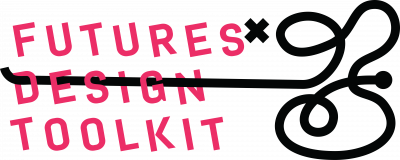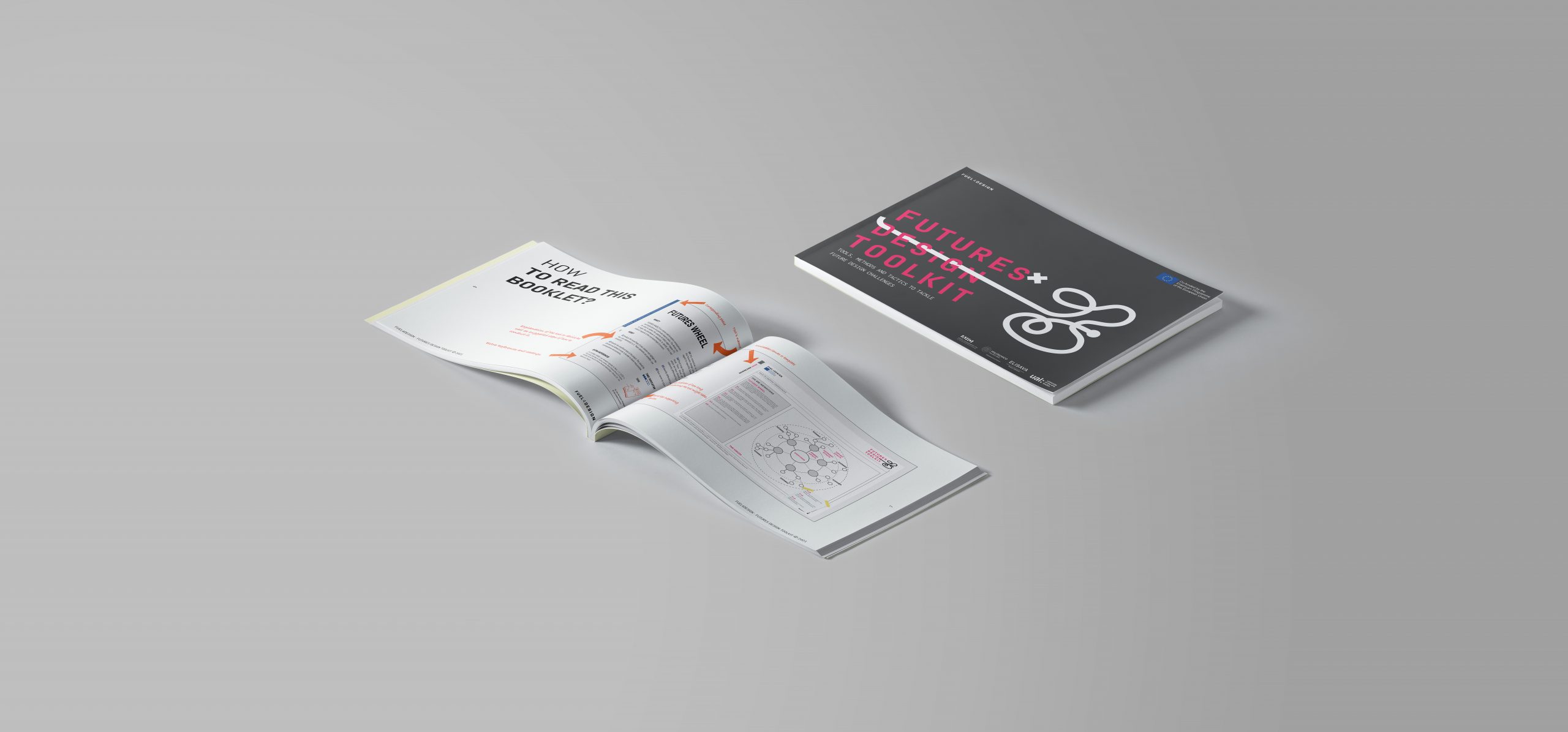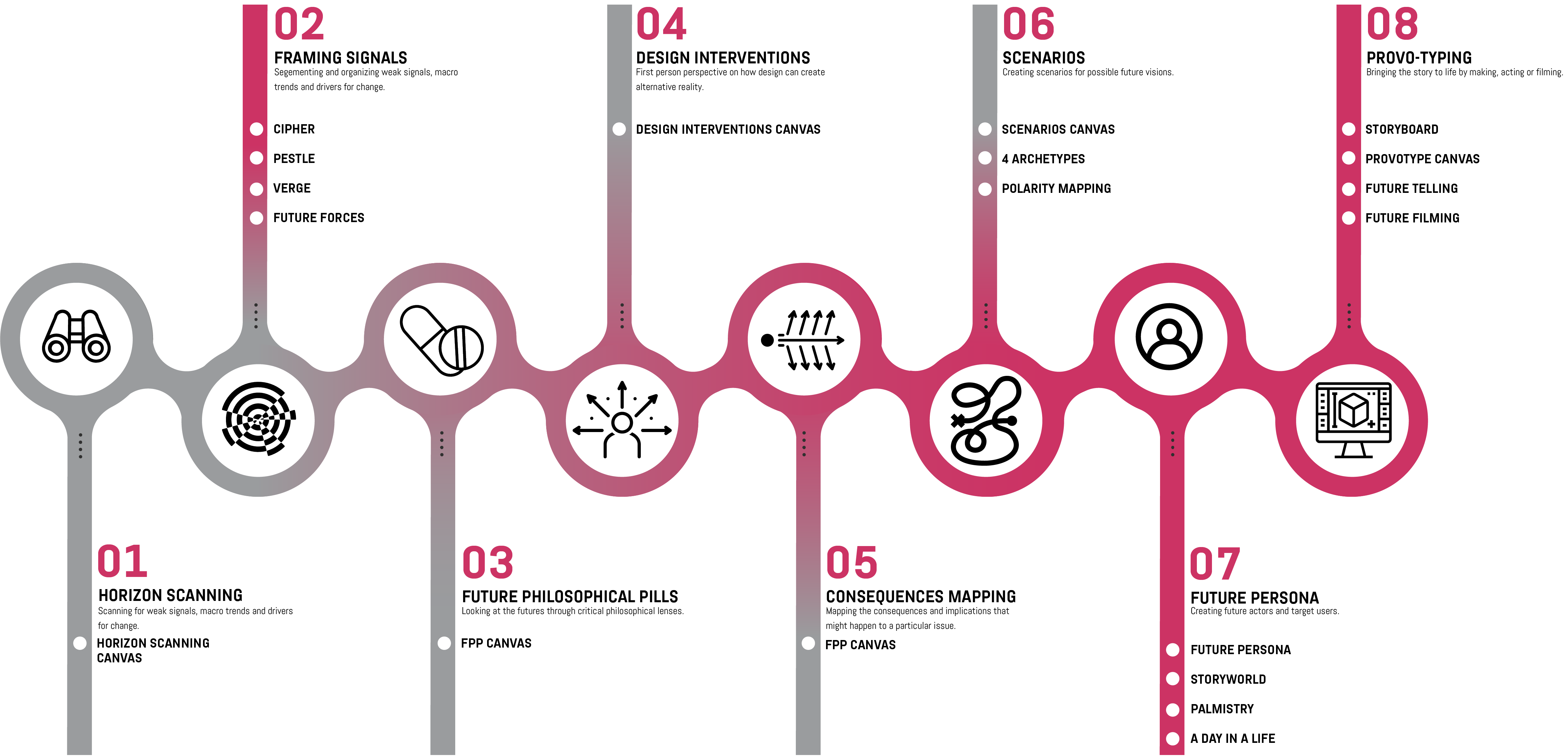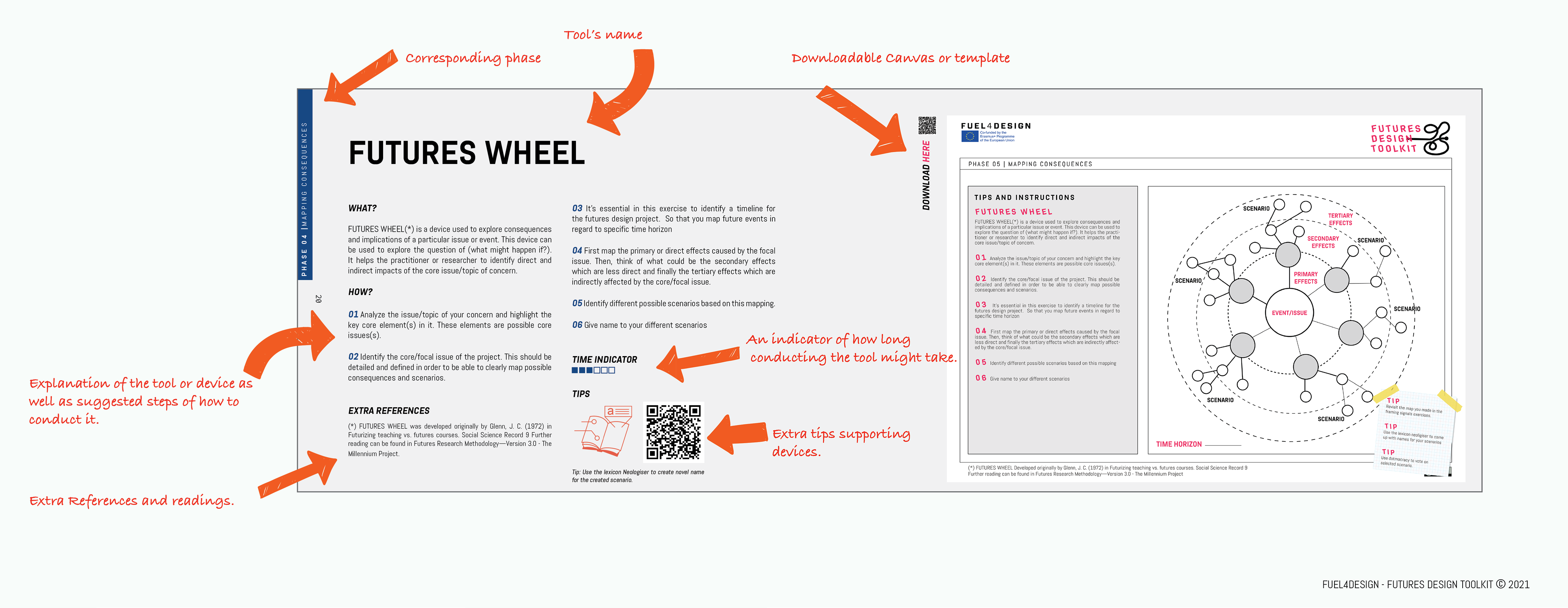
1.WHAT IS “FUTURES DESIGN TOOLKIT”?
The toolkit is a collection of methods, tools and tactics that can be used during the process of “Futures Design”. These tools and methods might be used as a catalyst agent in the design futures educational and research process. Considering the fact that many researchers and practitioners have proposed numerous ways of tackling design challenges in a “toolkit” format; the concept of a design toolkit or methods collection is very relevant to the design practice. The idea behind the toolkit is to create a repository of “various ways of performing particular design activities”. These ways vary greatly depending on the context concerned, resources available and time constraints. The tools, methods and devices in this toolkit are represented in a form of:
i) Template or canvas that designers can use to identify specific aspects of their design inquiry
or
ii) A diagramming device that helps users of the toolkit to breakdown or analyze an issue or topic
or
iii) A tool that helps users of the toolkit to build and generate ideas and concepts.
It also includes suggested activities, examples and some principles that can be followed. The toolkit acts a way to support a procedural activity where “steps can be followed” to achieve particular results.
In summary, the “Futures Design Toolkit” plays a role in creating a pool of “ways” and “suggestions” to perform activities in the context of design futures educational practice and research. On one hand, it facilitates the development of Design Futures literacy for design students through practicing and making. And on the other hand, it gears design educators with usable material to facilitate the teaching process of design futures courses.

2.WHY “FUTURES DESIGN TOOLKIT”?
Although we identified many tools and methods for design in general and for futures studies in particular. Design Futures methods and tools aren’t very well established on both the pedagogical level and practice-based one. There’s an urgent need to nurture the Futures Design process with tools and methods to be adopted along the process.
The aim of this “Futures Design Toolkit” is to nurture the Design Futures educational practice with methods and tools that should facilitate the process by leveraging futures’ literacy for design students and educators. Another aim of adopting these tools and methods is to facilitate, inform and boost the design process activities with ways to gather and integrate intelligence about the future.
The expected learning outcome of the toolkit is to educate students about:
i) The know-how of design futures.
ii) Tools’ & methods selection according to different contexts and processes
iii) Learning ways of application for the toolkit in further research and professional work.
3. WHAT ARE THE TOOLS, METHODS AND DEVICES INCLUDED?
We gathered and collated numerous tools and methods from different areas including design studies and futures studies. The selected were 15 tools that we collated in one toolkit. These tools are corresponding with the Futures Design process elements we developed during this project. These elements do not have to be sequential, they can be followed or used according to the nature of the project and desired design outcome. The developed elements are:

TOOLKIT ELEMENTS
01 Horizon Scanning
Horizon scanning can also be called blue-sky research. In this stage, weak signals, trends and drivers for change should be gathered and identified in order to develop wider understanding of the topic under investigation.
02 Framing Signals
At this phase, the gathered intelligence about the futures should be interpreted, categorized and organised. In a simple explanation, making sense of the gathered data according to particular categorisation and clustering techninques so that they can be utilised in the subsequent phases.
Tools included in this stage: PESTLE Analysis, CIPHER Analysis, VERGE and Futures Wheel.
03 Future Philosophical Pills (FPP)
This is one of the original outcomes of the FUEL4Design project. The aim of the Futures Philosophical Pills (FPP) is to interrupt existing or in the making design projects leading the process into a discursive practice. It supports the users of the toolkit not only to think and innovate but also to critique ideas about the futures.
Tools included in this stage: The FPP decks of cards
04 Design Interventions
The interventions stage refers to enacting change from a first-person perspective. It entails a tactic at which the designer or user of the toolkit can tackle futures by making and enacting actual change by creating alternative presents. It does acknowledge design action as the main driver and method which engages the practitioner in materialising futures.
05 Consequences Mapping
The aim of this stage is to map the implications and consequences of particular issue, trend or driver. The focal issue that is the core idea behind the topic under investigation should be mapped over a timeline to extrapolate the different possibilities or effects that might happen (either direct or indirect).
Tools included are: Futures Wheel, Branching
06 Scenarios
This is the stage where most of the gathered insights can be melted in one pot to formulate a solid and consistent scenario. The scenario is giving shape and coherent image to the envisioned world. This helps the user of the toolkit to better situate the design project and to look at a particular future scenario from deep and comprehensive perspective.
Tools included in this: Scenarios Canvas, Four Archetypes, Polarity Mapping
07 Future Persona
The persona represents fictional actors of the future scenario. This is the stage where users of the toolkit can work on situating actors in the developed scenario. It supports them to imagine how these actors would look like and how would they interact with the surrounding context.
Tools included in this stage: A Day in a Life, Futures Persona, Story World, Palmistry
08 Provotyping
The last stage is the Provo-typing. Provo-typing is a word that mixes between the word prototype and the word provoke. In other words, it means a provocative prototype. This stage is about the creation of discursive and provocative prototype aiming at creating a discursive space around the focal issue under investigation.
Tactics suggested in this phase: Storyboard, Provo-typing, Future Filming and Future-Telling.
4.How to use the toolkit:
Inside the toolkit document, there are several canvases or templates the include suggestions or instructions of use. Each canvas has the instructions written in the form of steps. Extra resources and references can be found in the dedicated page for each tool or method. Fig 01 represents a visual guide on how to read the booklet and what does each section indicate.
 HOW TO USE THE TOOLKIT
HOW TO USE THE TOOLKIT
5.EXPECTED IMPACT
This open resource will highly impact those that teach in the field of design but also more widely in the field innovation (Design Thinking, Project/Product Management) by providing both practical tools and guidance addressing the gaps, toward a more aware proficiencies of futures and with the aim of developing resilience abilities.
The impact is potentially large by way of them being shared as an open resources document and resource, freely usable by teachers and students. The toolkit will make it possible to connect courses and target to resources that are offered in the toolkit, where tailored us depends on contexts of use in open and specific use.
Design and foresight consultancies are also a constituency for the use of the toolkit.
6.TRANSFERABILITY POTENTIAL
The scope for transferability of this module is significant. The toolkit will directly impact those teaching in the field of design education by providing techniques for developing and delivering pedagogic practices in this area which in turn will impact the learners (PhD, MA /MS students) addressing the skills gap in this field.
This novel approach to the development of learning and teaching materials for emerging interdisciplinary and anticipatory practices will also influence and
contaminate other discipline connected to design practice. The application and the exploitation of the toolkit potential will be better clarified thanks to the construction of an organic methodology in Futures Literacy Methods.
7.FURTHER RESEARCH
We believe that this is an ongoing research project, the toolkit should not only grow over time adding new tools, methods and devices but also modifying and developing the existing ones.